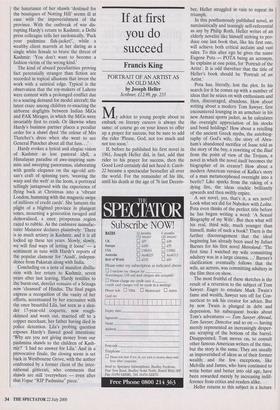Pseudo-
philanthropy in high places
Timur Moon
GOAT Agenuinely original, if sometimes rather bland novel, Goat is a curiosity. Comprising an essentially non-fictional, though imaginatively embellished account of the author's time in Kashmir, the tale is delivered in a mode ranging from travel reportage to front-line war correspon- dence. As an autobiographical memoir it offers a glimpse of the teeming streets of Delhi and the pastoral way of life in the Himalayas, whilst transforming them in a kind of imaginative intensification reminis- cent of Salman Rushdie.
Interspersed with grainy black-and-white photographs documenting Justine Hardy's mountain trail over the past decade, the nomadic herders and the traditional loom- weavers she encounters along the way, the novel is a record of what ultimately seems a rather flawed philanthropic foray into the couture export industry. An English jour- nalist with a penchant for cashmere, Hardy tells of glancing through Vogue magazine one day and, in a flash of inspiration, accu- rately predicting a trend for shawls in the coming season, specifically the raw pashmi- na shorn from the high-altitude mountain goat of the Ladakh region, known as Little Tibet. She promptly sets up business with a retired British backer, from which point the scene fluctuates between the strikingly antithetical co-ordinates of West London's health clubs and cappuccino bars and Kashmir's war-tom villages, to take in her globe-trotting shuttle missions, buying stock in rupees and exporting it to the Vogue readers of Holland Park Avenue, though all profit is ostensibly directed to funding Delhi's NGO slum schools.
Hardy combines a storyteller's artistry with the zeal of the investigative journalist, so that her venture assumes the dimensions of a moral campaign: a spiritual pilgrimage that becomes an altruistic mission, a rite of passage journeying into a war-zone, with the logistics of cashmere supply disrupted by the militias. But as she comes to admit, the luxuriance of her shawls 'destined for the boutiques of Notting Hill' seems ill at ease with the impoverishment of the province. With the outbreak of war dis- rupting Hardy's return to Kashmir, a Delhi press colleague tells her sardonically, 'Pack your pashmina flak-jacket!', while a wealthy client marvels at her daring as a single white female to brave the threat of Kashmir: 'You don't want to become a fashion victim of the wrong kind.'
The kind of absurd peculiarities proving fact perennially stranger than fiction are recorded in topical allusions that invest the work with a satirical edge. Typical is the observation that the toy-makers of Lahore were content with a prolonged conflict due to a soaring demand for model aircraft; the latest craze among children re-enacting the airborne dogfights between Indian MiGs and PAK Mirages, in which the MiGs were invariably first to crash. Or likewise when Hardy's business partner places a peculiar order for a shawl dyed 'the colour of Mrs Thatcher's dress when she went to see General Pinochet about all that fuss...'
Hardy evokes a lyrical and elegiac vision of Kashmir as lost pastoral idyll, a Himalayan paradise of awe-inspiring sum- mits and sweeping panoramas, elaborating with gentle elegance on the age-old arti- san's craft of spinning yarn, 'weaving the warp and the weft' at the loom, a portrayal tellingly juxtaposed with the experience of flying back at Christmas into a 'vibrant London, humming with the magnetic swipe of millions of credit cards'. She laments the plight of a blighted province in plangent tones, mourning a generation ravaged and demoralised, a once prosperous region razed to rubble. As the cashmere manufac- turer Manzoor declares plaintively: 'There is so much artistry in Kashmir, and it is all locked up these ten years. Slowly, slowly, we will find ways of letting it loose' — a sentiment in tune with Hardy's reports of the popular clamour for 'Azad?, indepen- dence from Pakistan along with India.
Concluding on a note of manifest disillu- sion with her return to Kashmir, seven years after last leaving, Hardy testifies to the burnt-out, derelict remains of a Srinaga now `cleansed' of Hindus. The final pages express a recognition of the vanity of her efforts, accentuated by her encounter with the once beautiful Lila, last seen as a slen- der 17-year-old coquette, now rough- skinned and worn out, married off to a copper merchant, her father having died in police detention. Lila's probing question exposes Hardy's flawed good intentions: `Why are you not giving money from our pashmina shawls to the children of Kash- mir?' I had no answer for Lila.' And in a provocative finale, the closing scene is set back in Westbourne Grove, with the author confronted by a former client of the inter- national glitterati, who comments that shawls are still `everywhere — even after that Vogue "RIP Pashmina" piece.'



























































 Previous page
Previous page